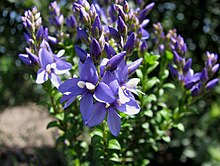Veronica formosa is a flowering plant species of the family Plantaginaceae, endemic to Tasmania in Australia.[2] It is a subshrub which grows to between 0.5 and 2 metres high. The elliptic to lanceolate leaves are 7 to 15 mm long. The flowers are pale lilac or violet blue and appear in racemes from late spring to early summer.[1]
| Veronica formosa | |
|---|---|

| |
| Scientific classification | |
| Kingdom: | Plantae |
| Clade: | Tracheophytes |
| Clade: | Angiosperms |
| Clade: | Eudicots |
| Clade: | Asterids |
| Order: | Lamiales |
| Family: | Plantaginaceae |
| Genus: | Veronica |
| Species: | V. formosa
|
| Binomial name | |
| Veronica formosa | |
| Synonyms | |
|
Derwentia formosa (R.Br.) Cockayne | |

Cultivation edit
Plants may be grown in shade, but a position in full sun is desirable to maximise flowering. They are frost tolerant, being hardy to -7 °C. A compact shape can be maintained by cutting back old stems after flowering.[1]
References edit
Wikimedia Commons has media related to Veronica formosa.
- ^ a b c Mulcahy, Tim (1986). "Veronica formosa". Growing Australian Plants. Australian National Botanic Gardens. Retrieved 21 January 2013.
- ^ "Veronica formosa". Australian Plant Name Index (APNI), IBIS database. Centre for Plant Biodiversity Research, Australian Government, Canberra. Retrieved 21 January 2013.